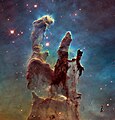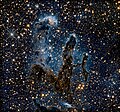Soubor:Eagle Nebula - GPN-2000-000987.jpg

Velikost tohoto náhledu: 606 × 600 pixelů. Jiná rozlišení: 242 × 240 pixelů | 485 × 480 pixelů | 776 × 768 pixelů | 1 035 × 1 024 pixelů | 1 944 × 1 924 pixelů.
Původní soubor (1 944 × 1 924 pixelů, velikost souboru: 1,18 MB, MIME typ: image/jpeg)
Historie souboru
Kliknutím na datum a čas se zobrazí tehdejší verze souboru.
| Datum a čas | Náhled | Rozměry | Uživatel | Komentář | |
|---|---|---|---|---|---|
| současná | 3. 10. 2012, 02:30 |  | 1 944 × 1 924 (1,18 MB) | Ras67 | losslessly cropped with Jpegcrop |
| 9. 4. 2009, 03:17 |  | 1 993 × 1 973 (1,45 MB) | BotMultichillT | {{Information |Description={{en|1=These eerie, dark pillar-like structures are columns of cool interstellar hydrogen gas and dust that are also incubators for new stars. The pillars protrude from the interior wall of a dark molecular cloud like stalagmite |
Využití souboru
Tento soubor nepoužívá žádná stránka.
Globální využití souboru
Tento soubor využívají následující wiki:
- Využití na ar.wikipedia.org
- Využití na arz.wikipedia.org
- Využití na en.wikipedia.org
- Využití na eu.wikipedia.org
- Využití na fa.wikipedia.org
- Využití na hu.wikipedia.org
- Využití na ka.wikipedia.org
- Využití na kw.wikipedia.org
- Využití na zh.wikipedia.org






